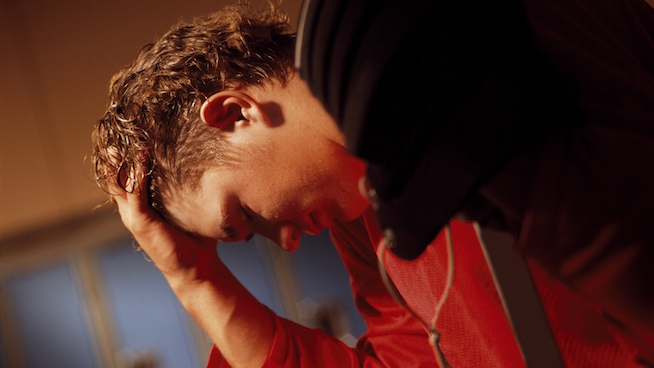How to Do Burpees to Build Endurance and Strength
A Burpee is a bodyweight exercise that combines a Push-Up with a Squat Jump to produce a move that challenges your mind as well as your muscles. Don’t let the silly-sounding name fool you: Burpees train your entire body and can build strength, but they’re even more well known for the way they challenge your conditioning and endurance.
Burpees were initially created in 1939 by Royal H. Burpee, who tested physical fitness by asking people to perform only four reps of the exercise. The movement was performed slowly and deliberately. Over time the Burpee has evolved into the fast-paced version that’s commonly performed in high-intensity interval training (HIIT) workouts, CrossFit WODs, Spartan Races, and countless workout finishers.
Want to add Burpees to your workout routine? Here’s everything you need to know to safely add the exercise to your workouts—if you think you can handle it.
- Burpee Form
- Burpee Mistakes
- Benefits of Burpees
- Burpee Muscles Worked
- Burpee Alternatives and Variations
- Burpee Workouts
How to Do Burpees
Step 1: Stand with your feet shoulder-width apart.
Step 2: Squat down and place your hands on the ground positioned like you would for a Push-Up.
Step 3: Kick your feet back to assume a push-up position.
Step 4: Lower yourself into a push-up until your chest touches the ground.
Step 5: Hop your feet toward your hands.
Step 6: Stand up and jump up into to the air, bringing your arms overhead—or clap them together overhead at the top of the jump. Land softly and repeat.
Common Burpee Mistakes
Avoid these common Burpee mistakes to ensure the exercise is safe and effective.
Mistake 1: Arching your back

Burpee Form Mistake: Arched Back
One of the worst and most common mistakes when doing a Push-Up is allowing your back to sag toward the ground. This puts stress on the spine and can lead to back pain.
This bad habit is exacerbated during Burpees. When they’re performed at a fast pace, it’s more challenging to be aware of your back position—and of course, even if you are aware, it’s tough to maintain that position as the set wears on and you tire out. Late in the set, your back is far more likely to look like a boomerang as you lower yourself to the ground.
To avoid this dangerous back arch, keep your core tight throughout the exercise. As you lower to the ground, think about tightening your abs and maintaining a flat back exactly as you would during a Plank or Push-Up. No exceptions. If you can’t maintain that engagement, stop the set—no matter what the rep count says.
If you have a problem holding a Plank or doing Push-Ups in the first place, you shouldn’t do Burpees. Instead, focus on building a stronger core. Our 27 Best Core Exercises for Athletes is the perfect place to start.
Mistake 2: Extreme back rounding

Burpee Form Mistake: Excessively Rounded Back
On the flip side of the arch, it’s also common to see a significant rounding of the back when squatting down and placing your hands on the floor, and when kicking your feet back to your hands.
Almost everyone rounds their back to some extent, and that’s OK. However, be mindful of this and do your best to avoid looking like Quasimodo.
Mistake 3: Landing hard
The Burpee has two main impact points: When you land from the jump and when you go down into the push-up position.
When you land from the jump, use the same technique you would use landing from any other jump. Try to land as quietly as possible. Bend your hips and knees to absorb the impact. You’re not going for a max jump. Getting lazy and landing hard adds unnecessary stress to your joints.
The same goes when you move down into the push-up position. Don’t just throw yourself onto the ground and land hard, stressing your wrists. Make sure to go through each of the specified steps in the exercise instructions so your shoulders and elbows don’t absorb too much impact.
Mistake 4: Doing too many reps
Most Burpee workouts are ridiculously difficult. The purpose of the exercise is to improve conditioning, burn calories and challenge the body.
Burpees are a relatively safe exercise, especially considering their difficulty, so they are great to perform at high intensities. But as mentioned above, your form will inevitably begin to falter as you become more fatigued.
When you hit what’s called technical failure—when your form breaks down but you can theoretically keep going with crappy form—it’s best to stop even if your workout calls for more reps. There’s no shame in protecting yourself against injury.
The Benefits of Burpees
Improved conditioning. Each of the moves that make up a Burpee—Deep Squat, Push-Up and Squat Jump—could be used to create a conditioning workout on their own. Combine them and you have a brutal exercise that will spike your heart rate and test your cardiovascular system—and of course, your mental toughness.
Torching calories. A single Burpee burns about 1.4 calories. Extrapolate this over multiple reps and you have a potent calorie burning exercise that will help burn fat. Better yet, add Burpees to a HIIT workout (you can find an example below) that maximizes the amount of calories that Burpees can burn.
Getting stronger. Burpees will develop general strength throughout your body. They’re not nearly as effective as lifting weights, but you will receive some strength benefits. Most importantly, you’ll learn to produce strength under fatigue, which is critical skill that athletes need late in games.
No equipment necessary. Finally, you don’t need expensive cardio equipment or even weights. You can do them virtually anywhere, assuming you have the willpower.
Burpees: Muscles Worked
Burpees are the quintessential full-body exercise. Everything from your legs, chest, back, arms and core work in this movement.
Burpee Alternatives and Variations
The following three Burpee variations provide a few examples of how you can alter the exercise to decrease or increase the difficulty.
Half Burpees
[youtube video=”cfPePK80aq0″ /]Half Burpees are easier to perform than standard Burpees because they don’t include a Push-Up. This is a great beginner option if you lack the upper body and core strength you need to perform full Burpees.
Single-Leg Burpees
[youtube video=”xDzWA2CpTeM” /]Keeping one leg in the air throughout the Burpee increases the difficulty of the exercise, challenges your core, helps eliminate left-to-right imbalances and simply looks cool.
Burpee Pull-Ups
[youtube video=”IcnxbHXu3Vc” /]Burpees are primarily an upper-body pushing exercise. Although the back plays an important role, it’s not actively targeted. Fix this problem by adding a Pull-Up to each rep. This not only builds back strength, it increases the caloric burn of each rep because more muscles are working.
Burpee Workouts
Here are three sample Burpee workouts that will improve your conditioning.
Burpee Tabata Workout
- Burpees – 8×20 sec. with 10 sec. rest between sets
Burpee 100-Rep Challenge
Perform 100 Burpees in as little time as you can, resting as needed. Time yourself and try to beat your score every time you take the challenge.
Burpee Hurricane Workout
Perform the grouped exercises (e.g., 1A, 1B, 1C) back-to-back in a circuit. Rest for 30 seconds after completing one round and repeat for three total rounds. Rest for 2 minutes before moving onto the next circuit.
- 1A) Burpees x 30 sec.
- 1B) Bodyweight Squats x 10
- 1C) Dead Bugs x 5 each side
- 2A) Burpees x 30 sec.
- 2B) Pull-Ups x 10
- 2C) Bird Dog x 5 each side
- 3A) Burpees x 30 sec.
- 3B) Reverse Lunges x 5 each side
- 3C) Rolling Side Plank x 5 each side
RELATED:
RECOMMENDED FOR YOU
MOST POPULAR
How to Do Burpees to Build Endurance and Strength
A Burpee is a bodyweight exercise that combines a Push-Up with a Squat Jump to produce a move that challenges your mind as well as your muscles. Don’t let the silly-sounding name fool you: Burpees train your entire body and can build strength, but they’re even more well known for the way they challenge your conditioning and endurance.
Burpees were initially created in 1939 by Royal H. Burpee, who tested physical fitness by asking people to perform only four reps of the exercise. The movement was performed slowly and deliberately. Over time the Burpee has evolved into the fast-paced version that’s commonly performed in high-intensity interval training (HIIT) workouts, CrossFit WODs, Spartan Races, and countless workout finishers.
Want to add Burpees to your workout routine? Here’s everything you need to know to safely add the exercise to your workouts—if you think you can handle it.
- Burpee Form
- Burpee Mistakes
- Benefits of Burpees
- Burpee Muscles Worked
- Burpee Alternatives and Variations
- Burpee Workouts
How to Do Burpees
Step 1: Stand with your feet shoulder-width apart.
Step 2: Squat down and place your hands on the ground positioned like you would for a Push-Up.
Step 3: Kick your feet back to assume a push-up position.
Step 4: Lower yourself into a push-up until your chest touches the ground.
Step 5: Hop your feet toward your hands.
Step 6: Stand up and jump up into to the air, bringing your arms overhead—or clap them together overhead at the top of the jump. Land softly and repeat.
Common Burpee Mistakes
Avoid these common Burpee mistakes to ensure the exercise is safe and effective.
Mistake 1: Arching your back

Burpee Form Mistake: Arched Back
One of the worst and most common mistakes when doing a Push-Up is allowing your back to sag toward the ground. This puts stress on the spine and can lead to back pain.
This bad habit is exacerbated during Burpees. When they’re performed at a fast pace, it’s more challenging to be aware of your back position—and of course, even if you are aware, it’s tough to maintain that position as the set wears on and you tire out. Late in the set, your back is far more likely to look like a boomerang as you lower yourself to the ground.
To avoid this dangerous back arch, keep your core tight throughout the exercise. As you lower to the ground, think about tightening your abs and maintaining a flat back exactly as you would during a Plank or Push-Up. No exceptions. If you can’t maintain that engagement, stop the set—no matter what the rep count says.
If you have a problem holding a Plank or doing Push-Ups in the first place, you shouldn’t do Burpees. Instead, focus on building a stronger core. Our 27 Best Core Exercises for Athletes is the perfect place to start.
Mistake 2: Extreme back rounding

Burpee Form Mistake: Excessively Rounded Back
On the flip side of the arch, it’s also common to see a significant rounding of the back when squatting down and placing your hands on the floor, and when kicking your feet back to your hands.
Almost everyone rounds their back to some extent, and that’s OK. However, be mindful of this and do your best to avoid looking like Quasimodo.
Mistake 3: Landing hard
The Burpee has two main impact points: When you land from the jump and when you go down into the push-up position.
When you land from the jump, use the same technique you would use landing from any other jump. Try to land as quietly as possible. Bend your hips and knees to absorb the impact. You’re not going for a max jump. Getting lazy and landing hard adds unnecessary stress to your joints.
The same goes when you move down into the push-up position. Don’t just throw yourself onto the ground and land hard, stressing your wrists. Make sure to go through each of the specified steps in the exercise instructions so your shoulders and elbows don’t absorb too much impact.
Mistake 4: Doing too many reps
Most Burpee workouts are ridiculously difficult. The purpose of the exercise is to improve conditioning, burn calories and challenge the body.
Burpees are a relatively safe exercise, especially considering their difficulty, so they are great to perform at high intensities. But as mentioned above, your form will inevitably begin to falter as you become more fatigued.
When you hit what’s called technical failure—when your form breaks down but you can theoretically keep going with crappy form—it’s best to stop even if your workout calls for more reps. There’s no shame in protecting yourself against injury.
The Benefits of Burpees
Improved conditioning. Each of the moves that make up a Burpee—Deep Squat, Push-Up and Squat Jump—could be used to create a conditioning workout on their own. Combine them and you have a brutal exercise that will spike your heart rate and test your cardiovascular system—and of course, your mental toughness.
Torching calories. A single Burpee burns about 1.4 calories. Extrapolate this over multiple reps and you have a potent calorie burning exercise that will help burn fat. Better yet, add Burpees to a HIIT workout (you can find an example below) that maximizes the amount of calories that Burpees can burn.
Getting stronger. Burpees will develop general strength throughout your body. They’re not nearly as effective as lifting weights, but you will receive some strength benefits. Most importantly, you’ll learn to produce strength under fatigue, which is critical skill that athletes need late in games.
No equipment necessary. Finally, you don’t need expensive cardio equipment or even weights. You can do them virtually anywhere, assuming you have the willpower.
Burpees: Muscles Worked
Burpees are the quintessential full-body exercise. Everything from your legs, chest, back, arms and core work in this movement.
Burpee Alternatives and Variations
The following three Burpee variations provide a few examples of how you can alter the exercise to decrease or increase the difficulty.
Half Burpees
[youtube video=”cfPePK80aq0″ /]Half Burpees are easier to perform than standard Burpees because they don’t include a Push-Up. This is a great beginner option if you lack the upper body and core strength you need to perform full Burpees.
Single-Leg Burpees
[youtube video=”xDzWA2CpTeM” /]Keeping one leg in the air throughout the Burpee increases the difficulty of the exercise, challenges your core, helps eliminate left-to-right imbalances and simply looks cool.
Burpee Pull-Ups
[youtube video=”IcnxbHXu3Vc” /]Burpees are primarily an upper-body pushing exercise. Although the back plays an important role, it’s not actively targeted. Fix this problem by adding a Pull-Up to each rep. This not only builds back strength, it increases the caloric burn of each rep because more muscles are working.
Burpee Workouts
Here are three sample Burpee workouts that will improve your conditioning.
Burpee Tabata Workout
- Burpees – 8×20 sec. with 10 sec. rest between sets
Burpee 100-Rep Challenge
Perform 100 Burpees in as little time as you can, resting as needed. Time yourself and try to beat your score every time you take the challenge.
Burpee Hurricane Workout
Perform the grouped exercises (e.g., 1A, 1B, 1C) back-to-back in a circuit. Rest for 30 seconds after completing one round and repeat for three total rounds. Rest for 2 minutes before moving onto the next circuit.
- 1A) Burpees x 30 sec.
- 1B) Bodyweight Squats x 10
- 1C) Dead Bugs x 5 each side
- 2A) Burpees x 30 sec.
- 2B) Pull-Ups x 10
- 2C) Bird Dog x 5 each side
- 3A) Burpees x 30 sec.
- 3B) Reverse Lunges x 5 each side
- 3C) Rolling Side Plank x 5 each side
RELATED:
















